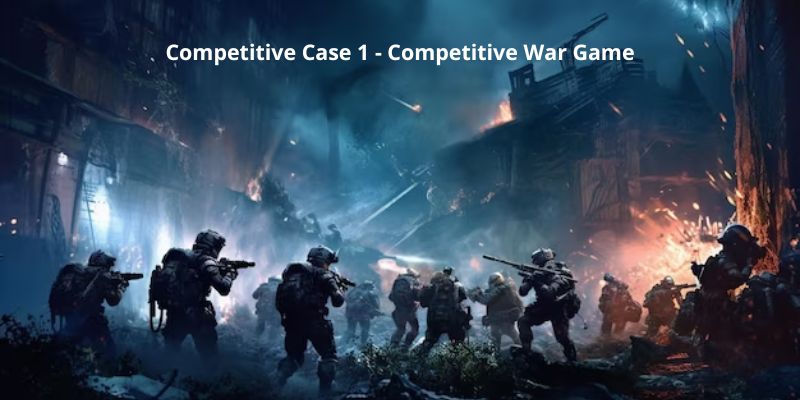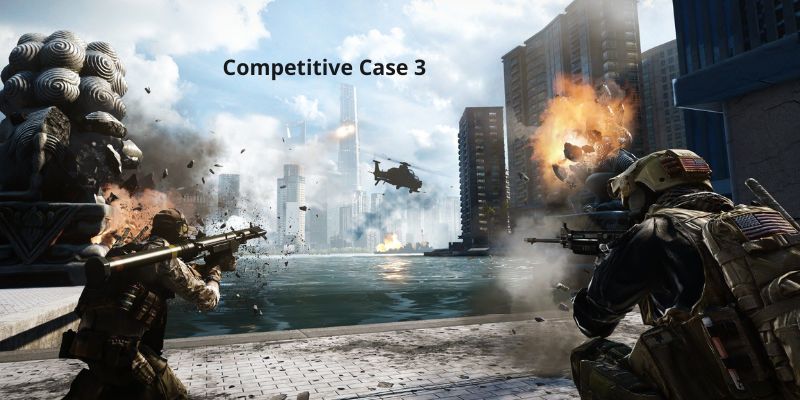In this article, the preparation required for a war game is described. The following is a list of potential candidate firms that may be gearing up for a war game. Furthermore, the paper concludes with a succinct list titled “Ten Steps of Business War Gaming.” Competitive War Games: Best Advantage on the Battleground by pubgfact.com.
Competitive Case 1 – Competitive War Game
Numerous important clients of Company A and rival companies are in the telecommunications sector, which is under regulatory pressure and might see changes in the nature of competition. Legislation that is still in the works may allow businesses from outside the telecoms sector to operate here. The company’s senior executives want to know how important competitors will act in expected situations so they can make better strategic decisions and watch for signs of developing situations. Competitive War Game

Competitive Case 1 – Competitive War Game
Competitive Case 2
A new product will be released by Company B in the upcoming year. Its managers seek to have a better understanding of the market, how its primary rival would react to the product introduction, and how it should react.
Competitive Case 3
A rival already has a small presence in the new geographic area that Company C is entering. Its executives are interested in learning about the competition’s present growth strategy for the area, how the competitor will respond to Company C’s plans when they learn about them, and how Company C may anticipate the competitor’s response.
In each of the aforementioned situations, an organization is dealing with serious problems that call for a greater comprehension of the external environment – its market, industry dynamics, and rivals – so that management may more effectively inform their competitive war game strategy, decisions, actions, and/or reactions. For circumstances like this, we can use a range of competitive techniques. The competitive war game is one of the most efficient.
Business war gaming, as its name indicates, borrows heavily from established military procedures, much like many other competitive intelligence tools and techniques. Competitors square up against one another in the marketplace just like enemies do on the battlefield. The aim is to secure competitive advantage among competitors by
- reducing hazards, dangers, and surprises
- maximum use of opportunities
- maximizing resources.
This may be achieved through
- understanding of potential solutions, shortcomings, and strengths
- Knowing and understanding the competitive environment, particularly the competition
- identifying prospective or anticipated developments
- considering the turmoil and uncertainty that make up the “fog of war.”

Competitive Case 3
In professional settings, this entails understanding the market, its dynamics, and influencing factors as well as “getting inside the heads” of competitors – or, in other words, grasping the battle landscape, gaining insights into how the competition will behave in the boardroom and on the field, and being as ready as possible for factors we can and cannot control.
Business war games, like military competitive war game, are exercises that simulate actions under certain circumstances or conditions to aid a company in developing strategies, developing courses of action, planning projects, and testing concepts. In order to establish agreement, cohesiveness, or concentration in their strategy, planning, or decision-making, businesses frequently engage in competitive war game when they are faced with novel or high-stakes situations, decisions, or events.
Games Companies Play
In its most basic form, a competitive war game entails the formation of two teams, one of which represents a rival firm, customer, market, or other business element and the other of which represents the “home” company, yet another rival company, client, market, or business component. Teams are created around a problem or issue, such as the upcoming product launch of a business or a competitor. In the beginning, one team representing the “home” firm can take certain measures toward the release of its product, testing them against those of their rivals.
The “home” team and the “competitor” team may proceed through phases or rounds of acts and answers as players advance through the war game exercise, examining different viewpoints, variables, and courses of action.
Each team must get adequate briefing on the nature and objectives of the war gaming exercise, the rules of play, and the role(s) and assignment(s) for each participant. It is important to provide participants with pertinent information and analysis that will aid them with their role-play. This might contain current activities, external impacting variables, firm, unit, management, and/or market profiles. Each team starts the exercise with the knowledge or resources provided to them, but as the exercise progresses, the opposing team or the facilitator may add additional elements, tasks, or even surprises that each team must take into account while deciding how to proceed.
The game may halt after each round so that players may assess the results of each phase. This keeps happening until the war game exercise’s goals are met. Each team presents its results to the other teams and other pertinent people as the war simulation comes to a close. Each team determines possible plans and actions that their organization is likely to or should take, taking into consideration important information and intelligence gaps. Teams should also discuss the most important lessons learned by their organizations from the war scenario exercise. Last but not least, any formal strategy, plan(s), contingency, and/or courses of action should be informed by the results of the war gaming exercise.
The scale and intricacy of war games can vary greatly. Every exercise should be created to take into account the unique circumstances of each firm. There are instances where different teams of different kinds are employed, with each team representing a different rival, your market(s), business issue(s), or other important factor(s). It is essential to work with a skilled and experienced coordinator and facilitator because of the importance of a war game exercise, the quantity and types of players, and the level of preparation, organization, and design necessary. Additionally, facilitators guarantee the integrity of the process by avoiding presumptions, blind spots, and other elements that could adversely impact the result.

Games Companies Play
Leaders are required for the competitive war game in addition to facilitators. Senior managers should support and actively participate in war games because they frequently involve strategic or other important issues, and the results are meant to guide management’s decisions and actions. They frequently take on the roles of team captains and referees or umpires. It is also essential to have the war game sponsor of the organization directly participate. Teams are made up of a mix of middle managers and key functional staff members who may provide a variety of viewpoints on the competition and the particular issue(s) and factor(s) under consideration.
Depending on the competitive/business competitive war game issue(s), gameplay model, resources, and urgency of the situation, a war game session may take from one to a few days. Similar variations exist in war game planning. Normally, it takes one month to prepare for a three-day competitive war game. This includes time for planning, identifying the competitive issue(s), assembling teams, briefing teams, doing research, performing preliminary analysis, and processing information. A war game may cost anything between $20,000 and over $500,000. Depending on the intricacy of the issue(s) at hand and the scope of the war game endeavor, these expenses may also include research, analysis, game design, and/or facilitation services.
pubgfact.com hope you will collect many knowledge through the above article: Competitive War Games: Best Advantage on the Battleground